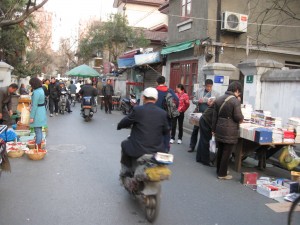There is logic to traffic in Shanghai, but I can’t quite figure it out. It’s always easier to figure out the rules of the road when you are actually driving, which in Shanghai should never be attempted by an amateur and will never be attempted by me. This could be a new stunt for a Jackass movie, riding a bike through Hongkou streets on a wet day when the brakes don’t quite work. When the traffic light indicates “walk”, this is not like crossing a street in Chicago, where a car may turn, likely after yielding. In Shanghai, the green walk man signals the beginning of a journey, and I truly understand the phrase “keep your head on a swivel.” Mopeds, motor bikes, electric bikes, busses, and taxis crochet patterns in the intersection, while pedestrians warily use the crosswalks. Here, the bikes operate on a different signal system, and they may still go. And busses will happily run a red light, as long as it’s close, or somewhat close.
There are many decisions to be made at these moments. Will the taxi stop for me or not? What is the critical mass of people necessary to make him yield? If I pack in with this group of three will he stop? Should I pause and let the motor bike swing in front of me or keep a steady pace and hope it weaves behind? Will the moped hit the bike? Will the bike hit the car? Will the bike hit the bike? I remember the analytical section of the SAT test. In the intersection, there is a bike, a taxi, a pedestrian, a motorbike, and a car. How many different collision combinations are possible? Or, in a more advanced Shanghai version, it would be like this: in the intersection, there are 2 busses, 100 pedestrians, 60 bicycles, 40 motor bikes, 20 taxis, and 5 private cars. How many collision combinations are possible, assuming that only two parties are involved in a collision? I would fail that one. For me, the correct answer is: I don’t care, as long as it doesn’t involve me.
For another look at Shanghai traffic, you may enjoy “6 Tips for Bicycling in Shanghai” by Nathan Stein.

